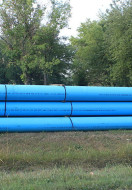Penicillium Mold is a mold commonly found on home inspections. Building Specs provides environmental home inspections to detect and test for this mold, we also have partners that can remediate Penicillium Mold. A wide number of organisms belong to this genus. Identification to species is difficult. Often found in aerosol samples. Commonly found in soil, food, cellulose, paint, grains, and compost piles. It is commonly found in carpet, wallpaper, and in interior fiberglass duct insulation.
Although this fungus is less allergy-provoking than the other molds, Penicillium is reported to be allergenic (skin) and it may cause hypersensitivity pneumonitis and allergic alveolitis in susceptible individuals. It can cause other infections such as keratitis, penicilliosis, and otomycosis.
Some species can produce mycotoxins including:
1) Ochratoxin: Which is damaging to the kidneys and liver and is also a suspected carcinogen; there is also evidence that impairs the
immune system.
2) Citrinin: That can cause renal damage, vasodilatation, and bronchial constriction.
3) Gliotoxin: Which is an immunosuppressive toxin, and
4) Patulin: That is believed to cause hemorrhaging in the brain and lungs and is usually associated with apple and grape spoilage. It can also cause extrinsic asthma.
- P. camemberti has been responsible for inducing occupational allergies among those who work with soft white cheeses on which the fungus grows.
- P. chrysogenum has been found on building materials, including paints, chip boards, and wallpaper. Cultivation - Potato dextrose agar or Malt extract agar, 24°C.
5) Penicillium brevicompactum:
Commonly found in water damaged carpet, wallpaper, and some types of insulation. Penicillium is reported to be allergenic (skin) and it may cause hypersensitivity pneumonitis and allergic alveolitis in susceptible individuals. It can cause other infections such as keratitis, penicilliosis, and otomycosis. Penicillium brevicompactum can produce the mycotoxin mycophenolic acid.
6) Penicillium chrysogenum:
This species, formerly known as Penicillium notatum, was one of the first known producers of penicillin. It is commonly found and can act as a food source for some types of dust mites. Penicillium chrysogenum is often found growing as a dark green colony and can produce the mycotoxins roquefortine C, chrysogine, and meleagrin.







